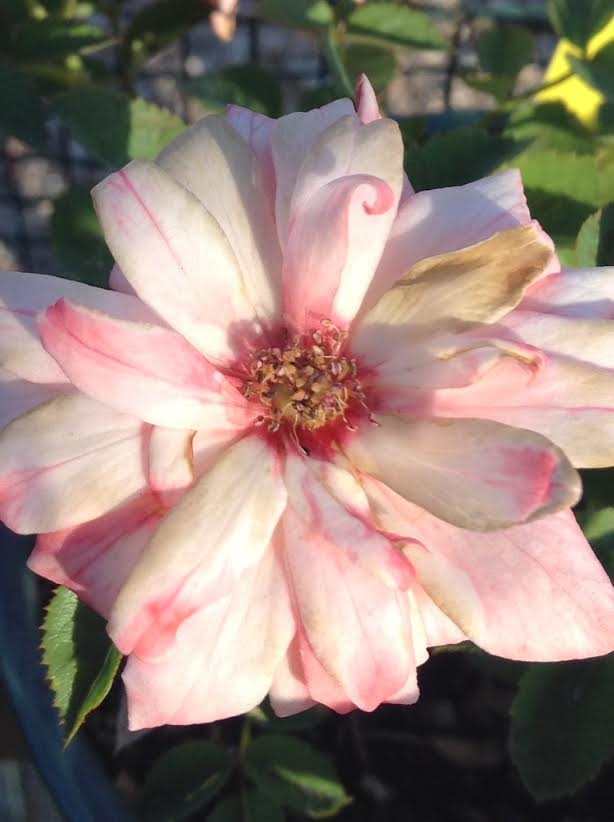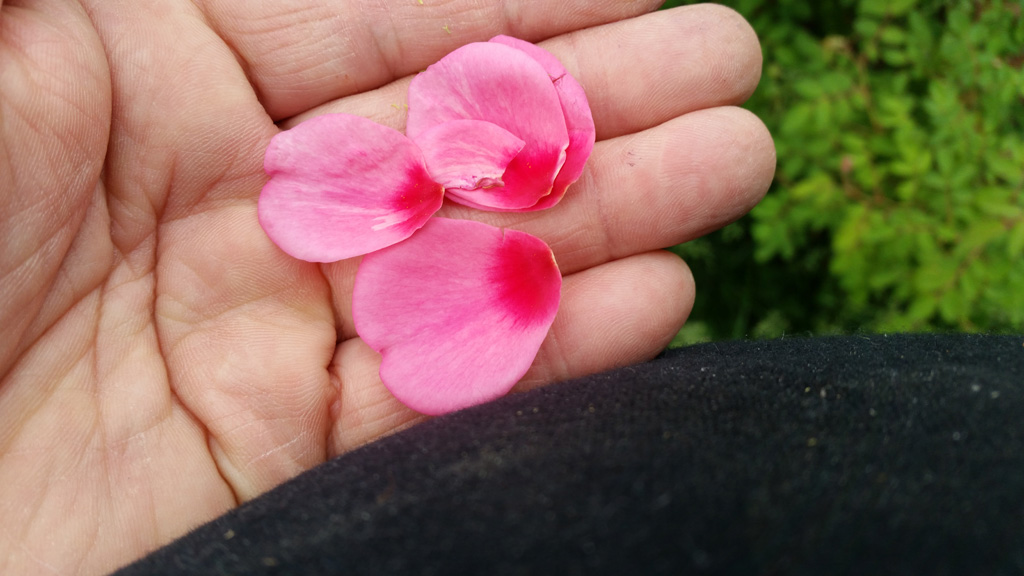I think this is a Show 'n Tell x Halo Glory cross, but tag missing so I can’t be certain. Old bloom but it does have the splotch!
Yay!

I think this is a Show 'n Tell x Halo Glory cross, but tag missing so I can’t be certain. Old bloom but it does have the splotch!
Yay!

Congratulations! It also is what First Impression ages to much of the time.
Congrats Judith. Is it more of a strong halo or a hulthemia blotch? If the latter, where’s it coming from in that cross??
Nice Judith! I’m still trying to obtain a blotch. This year I’m crossing Bull’s Eye and Eyes for you. Hopefully I’ll get as nice a blotch as you obtained.
The blotch I’m quite sure is from Halo Glory. As the tag was missing I can’t be positive, but I’d say it’s a 90% probability. Not a hulthemia cross that I know of, but maybe Kim can shed more light on the parentage of Halo Glory. I did get some seedlings from a hulthemia cross this season, but none had a blotch.
No Hulthemia involved in Halo Glory. Gold Badge X (Anytime X Angel Face).
Nice! If you would like Hulthemia blotches, Lychee Lemonade has been the most reliable of the lemonade series, but if you would like something even better, I would be happy to send you something this winter.
Jim, sign me up for the “something even better”! Ive been able to create a couple of good seed and pollen parents all from your M37-1 that you shared with me five years ago. Would love to increase the breeding blotch lines!
I would love it! Let’s talk this winter.
Jude
I understand that the Moore Halo and the Hulthemia Blotch are different patterns. Has anyone tried combining them to learn whether there is some interaction?
Mr. Moore did…
Persian Autumn 'Persian Autumn' Rose The pollen parent was “Anytime X Goldbadge” which was a Halo breeder.
Persian Sunset 'Persian Sunset ™' Rose "Ralph Moore’s Spring 2006 Minirama from Sequoia Nursery says that the pollen parent is an “un-named ‘Halo’ variety.” " Which could easily have been the same Anytime X Goldbadge.
Plus, there were quite a few other Halo X Tigris seedlings hanging around the nursery which were never introduced.
The seed parent of this seedling was Persian Sunset.

So, no spectacular interactions. One can always dream.
Next question
How is the Hulthemia blotching inherited? It appears to be dominant, at least in some crosses.
Does the trait segregate neatly (definite blotches vs. nothing) or are their degrees of expression?
Is the trait more emphatic when homozygous?
Here are my notes from an article by Jim Sproul posted somewhere on HMF:
“It appears that the “blotch” gene (or genes) is linked to genes coding for non-remontancy (that is non-repeat blooming), willowy growth, disease susceptibility and needle-like prickles. It also appears that there are several aspects of the blotch itself that may be independently coded for: blotch size and shape, blotch color, and intensity of color.”
“The blotch itself seems to be transmitted as a dominant characteristic. What is not clear to me is whether the blotch is coded for by a single gene, or by multiple genes. The blotch varies considerable in size and intensity, and has been seen in various colors from orange, to red, to purple.”
Jim needs to add more here as he has shared quite a bit in new photos on Face Book. The blotch appears to have morphed its expression quite a bit into other petal color forms and combinations.
Do you have a link, Kim?
Face Book
Here are a few of the morphed splotch photos. The blotch appears to be breaking up into stippling through the center of the petals.
I can also confirm it’s dominant gene. Having raised many hundreds (or more) seedlings from the diploid Sweet Spot Calypso, many being selfed OP’s (every flower turns into a hip, I sow everything…), there’s instances where the blotch isn’t inherited (indicating SSC is heterzygous for the gene/s) or the blotch is tiny (possibly some other gene/s affect it’s appearance). In the vast majority of cases though it’s selfings are blotched…which would be expected if using simple mendelian theory.
Intentional crosses is more of a mixed bag, it’s still roughly half having a blotch, but the appearance of the blotch varies more in size and strength.
"It appears that the “blotch” gene (or genes) is linked to genes coding for non-remontancy (that is non-repeat blooming), willowy growth, disease susceptibility and needle-like prickles. "
Ehh…not convinced. If close to species, it’s likely just the lack of filtering out the other genes yet rather than specific linkage like Moss and Thorns. The species being adapted to such a vastly different environment to the average person’s garden and not really fitting the desired aesthetic for plant architecture…it’s just not likely to mesh well out of the box with anything.
Tigris is first gen from and is listed as an occasional repeater despite persica being a once bloomer.
Sweet Spot Calyspo is a continous bloomer as are the few children I’ve kept of it, it’s not willowy, more shrubby/upright. It’s also fairly low thorn (granted one of it’s selfed yellow seedlings I have has very spiky hips as a more matured plant, assume a throw back to the species). SSC’s health is poor though.
Bright As A Button/Raspberry Kiss and Candy Eyes have nasty thorns but very healthy here, BAAB/RK is 4th gen from.
I found some answers to my questions … asked and unasked … on Jim Sproul’s blog.
There are some really exciting possibilities in there, and even more (perhaps) when combined with reverse bicolors (more red pigment on reverse).
Thank you for finding that, Karl. That is what I had earlier referred to. Kim